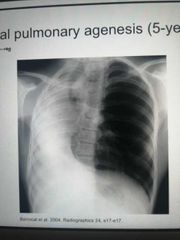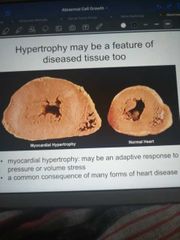![]()
![]()
![]()
Use LEFT and RIGHT arrow keys to navigate between flashcards;
Use UP and DOWN arrow keys to flip the card;
H to show hint;
A reads text to speech;
26 Cards in this Set
- Front
- Back
|
What are the two types of decreased growth? |
Developmental - occurs during pregnancy Progressive - occurs during life |
|
|
What are the 3 types of increased growth? |
Hypertrophy - increased cell size without proliferation Hyperplasia - increased cell division while maintaining size Neoplasia - umbrella term describing benign tumours, cancer, leukemia, lymphomas |
|
|
What are the two types of decreased developmental growth? |
Agenesis - complete failure to develop, as in renal/pulmonary agenesis Hypoplasia - partial failure to develop, eg. testes in Klinefelters syndrome or ovaries in turner's syndrome |
|
|
Give an example of agenesis |

Unilateral pulmonary agenesis (one lung) |
|
|
What are the two types of progressive decreased growth? |
Physiological - eg. Natural involution of thymus during puberty Pathological - cachexia (General wasting) or Atrophy |
|
|
What is the thymus? |
Bi-lobed organ, develops T lymphocytes |
|
|
What might cause local atrophy? |
Disuse of muscles Pressure from cyst, tumour or aneurysm Ischaemia (lack of blood supply) Neuropathy Idiopathy (unknown cause eg. in parkinsons) |
|
|
Describe hypertrophy |
Characteristic of 'permanent tissues' such as muscle Increase in cell size without corresponding number increase |
|
|
When might hypertrophy be a Pathological condition? |

Myocardial hypertrophy as a response to pressure or volume stress |
|
|
Describe hyperplasia |
Typical of 'renewing tissues' such as epidermis Increase in cell number while maintaining cell size Liver after surgery or blood cells at high altitude |
|
|
When might Hyperplasia be a Pathological condition? |
Graves' disease, auto-immune disease against TSH receptor, causes hyperthyroidism by increase in size of thyroid |
|
|
Describe neoplasia |
Excessive proliferation of one cell type Results from cumulative genetic mutations Abnormal, no function Typically progressive |
|
|
What is a papilloma? |
A benign tumour of surface epithelium |
|
|
What is a carcinoma? |
A malignant tumour of surface epithelium |
|
|
What is an adenoma? |
A benign tumour of Glandular epithelium |
|
|
What is an adenocarcinoma? |
A malignant tumour of glandular epithelium |
|
|
Fibromas, lipomas, and haemangiomas are examples of which type of cancer? |
Benign tumours of a type of mesenchymal tissue |
|
|
What do you call a malignant fibroma? |
Fibrosarcoma |
|
|
Why are tumours of mesenchymal origin more rare than of epithelial origin? |
Because mesenchymal cells have a lower proliferation rate |
|
|
What do you call a haematological lymphoid tumour? |
Lymphoma or a lymphoproliferative disorder |
|
|
What do you call a haematological bone marrow tumour? |
Myelodysplasia or leukemia |
|
|
Give an example of a papilloma? |
Squamous cell papilloma, wart on the skin |
|
|
What is a colorectal adenoma polyp? |
Benign tumour arising on the inner surface of the intestines, caused by an inherited mutation in Adenomatous Polyposis coli (APC) tumour suppressor gene |
|
|
Describe the features of benign tumours |
Grow by local expansion Don't invade adjacent tissue Cannot spread through basement membrane May cause harm through pressure or obstruction May progress to malignancy |
|
|
Describe the features of malignant tumours |
Grow by Invasion of local tissues Can traverse basement membrane Differentiation is incomplete Nuclei are often large Cause harm through destruction of local tissue |
|
|
What is pleomorphism? |
When a tumour has multiple cell types |

